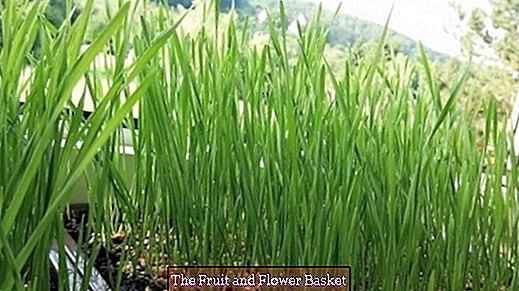Grow wheatgrass yourself
Recently, more and more wheatgrass products are being advertised. A new hype, or is it really because of the health promoting properties of the sweet grass? At any rate, it is clear that wheatgrass can be grown cheaply and thus save expenditure on expensive finished products.
Many healthy ingredients
Wheatgrass (botanical Triticum aestivum) is originally a cross between various types of cereals and wild grasses. It contains a lot of vitamin A (or beta-carotene, which is converted by the body in vitamin A), vitamins B6, C, E and K, as well as minerals, such as iron, selenium, manganese, zinc, magnesium, cobalt, phosphorus and Germanium and essential amino acids for the body and essential fatty acids such as linolenic acid.
The young grass can either be consumed directly or processed into juice and powder. The best are 10 to 15 cm high stalks, which contain a lot of chlorophyll and other nutrients.
Wheatgrass has a detoxifying and anti-inflammatory effect
All Wheatgrass products are designed to detoxify the body by stimulating liver function and improving blood oxygenation.
Due to its anti-inflammatory properties, wheatgrass is used for colds, mouth and throat infections, bronchitis, joint pain, arthritis or skin diseases. By the way, wheatgrass is lactose- and gluten-free, so it is also suitable for people with these food intolerances.
Pull wheatgrass yourself
Wheatgrass can be grown in suitable bowls even at home. Seeds are available at the health food store or health food store. As germination dishes and household standard trays can be used.
The seeds (about two cups) should first be soaked for several hours in a bowl of water (covered). Then rinse and repeat until small roots have formed. Meanwhile lay out the trays with kitchen paper and give it possibly a few centimeters potting soil on it (goes without). Then the seedlings are evenly distributed and lightly pressed to the surface. Instead of a watering can, please use a spray bottle to moisten the young shoots. This should be done about once a day so they do not dry out. In addition, a layer of damp newsprint can be placed over the trays in the first few days.
Attention: The plantlets should not be too wet, so that nothing changes, and they do not like direct sun, so look for a shady place for the trays. If the grass is about 15 cm high and split (after about ten days), it can be harvested. To do this, cut it off directly above the root with scissors. This way you can harvest from a tray up to three times.
Eat directly or continue processing
The fresh wheatgrass can be used in smaller quantities such as herbs in the kitchen, eg. B. cut into salads, soups or directly on the bread. Even in a smoothie it feels good. However, too much of a good thing can cause stomach or bowel problems.
If you do not like the slightly fibrous consistency, you can also grow a special juicer and even make wheatgrass juice. Recommended is a drinking volume of about a shot glass (40 milliliters) daily. Or you dry the grass and grind it to powder, which is much more complex.
Beware of finished products
Of course you can also buy juice and powder. However, "Öko-Test" found pesticides and mineral oil traces even in organic wheatgrass powder last year. So if you want to play it safe, you should go to the trouble and grow the grass yourself. In particular, experts warn against wheatgrass seeds and "products from China, because they are particularly contaminated with pesticides. Of course, there is also the long transport route.
And now a tip for last: Who breeds several trays at intervals of a few days, always has a harvest fresh available, as long as the others regrow! Good appetite and good health! Buy now ![]() A.Vogel wheatgrass bioSnacky (germ seed) - 1 pack (1 x 200g) - BIO 0,00 ?
A.Vogel wheatgrass bioSnacky (germ seed) - 1 pack (1 x 200g) - BIO 0,00 ?





